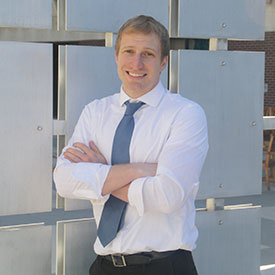 Ryne Ramaker decided to enroll in UAB's M.D./Ph.D. program after completing the Summer in Biomedical Science Program.During the summer of 2010, after completing his sophomore year at the University of Arkansas at Little Rock, Ryne Ramaker spent eight weeks conducting biomedical research in Birmingham. As a participant in UAB’s Summer in Biomedical Science (SIBS) program, Ramaker did hands-on research under experienced physician-scientists and learned firsthand about the opportunities to combine both clinical and research training. Six years later, he has completed the first two years of medical school at UAB and is currently conducting Ph.D. research at the HudsonAlpha Institute for Biotechnology in Huntsville as part of the School of Medicine’s Medical Scientist Training Program (MSTP).
Ryne Ramaker decided to enroll in UAB's M.D./Ph.D. program after completing the Summer in Biomedical Science Program.During the summer of 2010, after completing his sophomore year at the University of Arkansas at Little Rock, Ryne Ramaker spent eight weeks conducting biomedical research in Birmingham. As a participant in UAB’s Summer in Biomedical Science (SIBS) program, Ramaker did hands-on research under experienced physician-scientists and learned firsthand about the opportunities to combine both clinical and research training. Six years later, he has completed the first two years of medical school at UAB and is currently conducting Ph.D. research at the HudsonAlpha Institute for Biotechnology in Huntsville as part of the School of Medicine’s Medical Scientist Training Program (MSTP).
“I had very little research training prior to my SIBS experience and knew very little about the physician-scientist career track,” he says. “With the SIBS program, I was able to dive headfirst, full-time into a project under the supervision of a well-established physician-scientist and work alongside other physician-scientists in training. I also received invaluable career advice and exposure to training opportunities I would have never received otherwise. I would not be in the MSTP today without the experiences SIBS provided.”
Summer programs like SIBS and PARAdiGM (Preparation for Graduate and Medical Education), a companion research program for outstanding undergraduates from disadvantaged and underrepresented minority backgrounds, have become important vehicles for both recruiting graduate students and raising UAB’s profile throughout the biomedical research community.
“A hands-on research program is one of the only ways for students to really understand what biomedical research is all about and if it’s a field they want to pursue,” says Robin G. Lorenz, M.D., Ph.D., associate dean for physician-scientist development. “I was exposed to biomedical research through a similar summer program, so I know that it can allow students to see what an academic medical center is like and become a part of the excitement of being a physician-scientist.”
 The SIBS program accepts 15 undergraduate students each summer for an eight-week paid research program. Students are assigned to individual scientists based on their stated scientific interests. Each participant conducts independent research under the supervision of senior researchers, and presents his or her findings at the end of the summer.
The SIBS program accepts 15 undergraduate students each summer for an eight-week paid research program. Students are assigned to individual scientists based on their stated scientific interests. Each participant conducts independent research under the supervision of senior researchers, and presents his or her findings at the end of the summer.
As a SIBS student, Ramaker worked with researchers in the oncology division to assess a novel therapy for hepatocellular carcinoma, the most common form of liver cancer, that involves administering low-intensity electromagnetic fields. The project ultimately resulted in a paper published in the British Journal of Cancer.
Thanks to the success of the SIBS program, the NIH awarded UAB with additional funding in 2014 to launch PARAdiGM. This program, which is integrated with SIBS, supports 10 students each summer from disadvantaged backgrounds and groups underrepresented in science/medicine. And the programs continue to grow. For 2016, more than 300 undergraduate students have applied for SIBS and PARAdiGM—more than double the applicants for 2015.
SIBS and PARAdiGM act as a pipeline for UAB’s medical school and biomedical research graduate programs and help spread the word about UAB. “Exposure to the resources and facilities available at UAB certainly played a big role in my decision to choose UAB over other programs in the region,” Ramaker says.
“These are opportunities to showcase our strengths,” Lorenz says. “Even the students who don’t eventually come here will share their experiences at UAB wherever they end up in the medical research community.”
By Nancy Mann Jackson